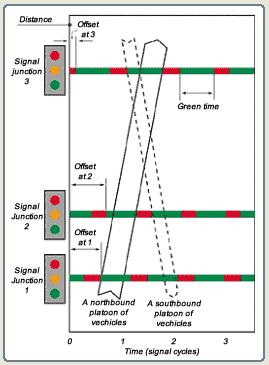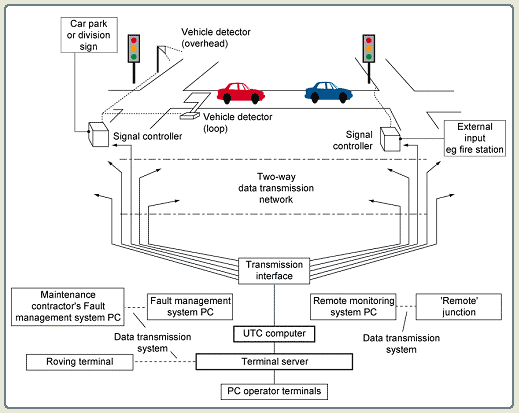


 



  
|

Taxonomy and description
Terminology
Types of UTC systems
Technology
Terminology
Urban traffic control (UTC) systems are a specialist form of traffic management which integrate and co-ordinate traffic signal control over a wide area in order to control traffic flows on the road network. Integration and co-ordination between adjacent traffic signals involves designing a plan based on the occurrence and duration of individual signal aspects and the time offsets between them and introducing a system to link the signals together electronically. A traffic responsive signal control system is a means of adjusting the traffic signal settings (cycles, green splits and offsets), which optimise a given objective function, such as minimising travel time or stops, in real-time based upon estimates of traffic conditions.

An idealised time-distance diagram showing signal co-ordination with a fixed time plan
(http://www.roads.dft.gov.uk/roadnetwork/ditm/tal/traffic/07_99/)
UTC systems can provide the basis for an extended control system, generally termed Urban Traffic Management and Control (UTMC) (Routledge et al, 1996). They include incorporating emergency service vehicles and priority for public transport such as bus priorities, and their integration with information systems such as variable message signs, real-time driver information systems and route guidance and parking guidance and information system.

Types of UTC systems
There are many different UTC systems in operation around the world, but they can be distinguished into two basic types based on different control strategies. These are fixed time systems and traffic responsive systems. The following provides an overview of the capabilities of some fixed time and adaptive UTC systems (Wood, 1993; IHT, 1997):
- Fixed time systems
Many UTC systems are variants of this type of system. The method used to calculate the timings defines the objective that the system will seek to minimise. This is often used to minimise network vehicle delay. The designer has considerable control over his objectives and can optimise different parts of the network in different ways to give different objectives. Although the timings can be biased against the main traffic movements, traffic can be restrained by adjusting the splits at critical junctions. Also, the cycle time can be kept low to reduce total capacity and extra stages can be introduced at junctions to reduce the green time available for the main traffic movements.
Fixed time systems cannot respond dynamically because they use pre-calculated timing plans. Therefore, the systems do not respond automatically to incidents, such as accidents, which cause loss of capacity in the network. In addition they will not respond to changed demand when a route guidance system is working. Most importantly, they do not respond to changes in traffic patterns over time. Fixed time plans are good at implementing fixed strategies, such as limiting traffic capacity as certain times of day.
- Plan selection systems
Plan selection systems use fixed time plans, but select which plan to use by information from detectors strategically placed in the network, rather than by time of day. However, this system has not been shown to be better than simple time-of-day implementation of fixed time plans. If necessary, they can be forced to run a specific plan for a special event. Some decisions made by plan selection logic prove to be inappropriate. The extra delay caused by choosing the wrong plan cancels the benefit of changing plan at the right time when the logic makes a good decision. Therefore, plan selection systems almost have the same advantages and disadvantages as fixed time systems.
- Plan generation systems
Plan generation systems generate their own fixed time plans from detector data and implement them. Compared to fixed time operation, the system is much less under the control of the traffic engineer because it is not as easy to define exactly how the system should operate. In principle the system could respond to unexpected incidents, although in practice it may not be allowed to make a large enough change to the existing plan to respond effectively.
- Local adaptation
Some systems use a measure of local adaptation at the controllers to modify the action of centrally imposed fixed time plans. The basic operation is that an appropriate fixed time plan is run and the local controllers can omit or terminate early the side road stages depending on the local demand for the stage in the current cycle. Local adaptation then increases the main road green in some cycles, which should lead to better progressions on the main roads. Local adaptation is usually combined with plan selection or plan generation.
- Traffic responsive centralised systems
Traffic responsive systems are fully dynamic. The system is based on a central computer and communication to individual traffic controllers. The advantages of responsive systems are that they should respond to traffic demand, day-to-day variation, unexpected incidents and trends over time. A responsive system adjusts its control to react to changing inputs from its traffic detectors. In principle, similar techniques can be used to respond to other inputs from real-time driver information systems and route guidance. A centralised system has the advantage that all the relevant information, from the detectors and other sources is available in the same place.
- Traffic responsive systems with distributed processing
The features and advantages of distributed responsive systems are basically the same as those of centralised responsive systems. A major difference is in the communication systems used. A centralised responsive system has continuous communication between each controller and the central computer. A distributed responsive system has a router module and each controller is connected to the neighbouring controllers. Messages can be passed between any two controllers, routing the message by intermediate controllers where necessary. A distributed responsive system should be able to work with a route guidance system, but the interaction will be more complicated than for a centralised responsive system.
Wood (1993) reviewed existing UTC systems in the world. The following table shows the name and types in major UTC systems around the world.
Type |
System |
Country |
Fixed time systems |
TRANSYT |
UK |
Plan generation systems |
SCATS |
Australia |
Traffic responsive centralised systems |
SCOOT |
UK |
|
UTMS |
Japan |
Traffic responsive systems with distributed processing |
OPAC |
USA |
|
PRODYN |
France |
|
UTOPIA / SPOT |
Italy |
*Acronym
TRANSYT Traffic Network Study Tool
SCATS Sydney Co-ordinated Adaptive Traffic System
SCOOT Split, Cycle and Offset Optimisation Technique
UTMS Universal Traffic Management System
OPAC Optimisation Policies for Adaptive Control
UTOPIA Urban Traffic Optimisation by Integrated Automation
SPOT System for Priority and Optimisation of Traffic
The programs of UTC systems defined three generations of traffic control (Venglar and Urbanik, 1995). The first generation were the fixed time systems, which consisted mainly of timing plans that were developed from off-line analysis programs and stored in computer memory. TRANSYT was of this generation and has been developed in UK since the 1960s. TRANSYT is used in many countries around the world and is the effective world standard method of calculating fixed time signal plans.
The first-and-a-half generation is something of a hybrid, which automated the timing plan development process and detected when precalculated timing plans should be modified. Plan selection systems, plan generation systems and local adaptation are included in this generation. The best known system of this type is SCATS in Australia . Since 1983 SCATS has been installed around the world and is currently used in over 70 urban centres in 15 countries with a wide user base of systems.
Second generation systems involved the real-time production and implementation of plans through on-line techniques based on surveillance data gathered from vehicle detectors. Timing plans are implemented periodically, of the order of once every five or ten minutes. SCOOT, developed in UK , is of this generation. SCOOT has been introduced is now used in over 170 towns and cities in the UK and overseas.
The third generation implements and evaluates a fully traffic-responsive, online control system. Signal timing parameters must be changed continuously in response to real-time measures of traffic variables. Third generation systems are being developed today with distributed intelligence such as OPAC, PRODYN, UTMS and UTOPIA.
Technology
IHT (1997) reviewed the main technology of UTC systems. Traffic signals in a UTC area are usually controlled by a central computer, which sends electronic instructions by telephone-type cables to each junction signal controller. Signal controllers receive traffic information from vehicle detectors installed near the stop line on side roads. Inductive loops, microwave detectors and video-processing detection systems can be used as presence detectors. Inductive loops are also used to measure traffic volumes, detector-occupancy and speed in traffic responsive systems occasionally. Local co-ordination may also be achieved either by linking controllers by dedicated cable or by cableless links between microprocessor-based controllers.
Transmission of the data from the central computer is by means of in-station transmission units (ITU). These receive the signals from the computer and transmit the information to the various junctions, by means of time-division or by frequency-shift multiplexing, which accommodates several channels on each data-line by the use of data-concentrators at either end of the line.
At each of the junctions controlled by the central system, an out-station transmission unit (OTU) is installed in the controller. This receives the signal from the data-line and interfaces with the local control equipment. The OTUs use transmission protocols which are specified by the manufacture of the in-station transmission system and similar units have to be used in any subsequent expansion of the system.
UTC systems generally include a number of graphic display facilities, which offer a fuller understanding of the traffic situation in the control area. The facilities include diagrams, giving information about queue build-up and dispersal, displays of individual junction operation and time distance diagrams, to assist in analysing traffic flow and journey times.
A roving terminal is a portable terminal which communicates with the UTC systems via a cellular radio link. This provides access to the system from any location, making direct comparisons between the actual traffic and the situation being modelled.
Some intelligent transport systems technologies such as Automatic Incident Detection (AID), CCTV Surveillance are used for the extension of UTC systems.

The flow of information in SCOOT based UTC system

|




